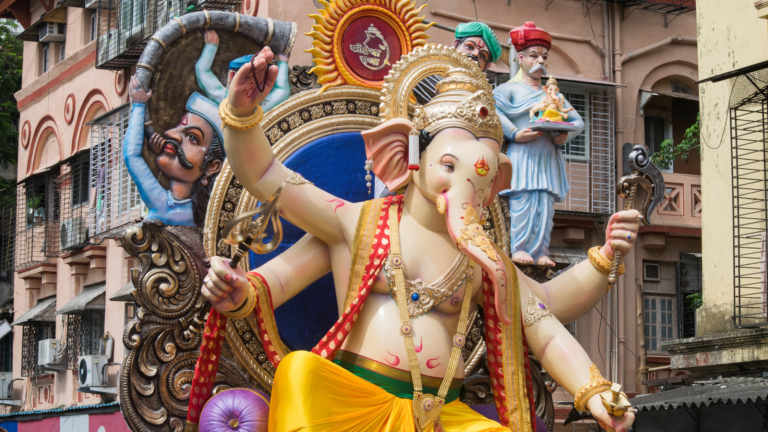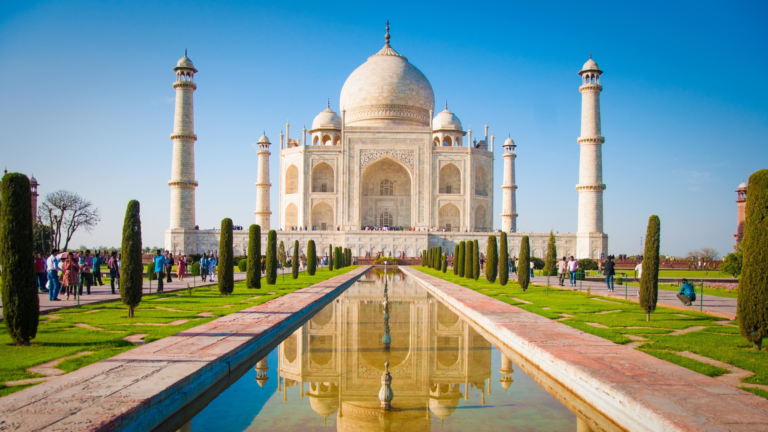India is a land of rich history, with ancient forts, palaces, and temples that tell the tales of its storied past. For history enthusiasts, exploring India’s historical sites is like stepping into a time machine that takes you back through centuries of diverse cultures, grand empires, and architectural marvels. In 2025, make it a point to explore these top 10 historical places in India that showcase the country’s heritage, grandeur, and timeless beauty.
1. The Taj Mahal – Agra, Uttar Pradesh
The Taj Mahal is India’s most iconic monument and one of the Seven Wonders of the World. Built by Emperor Shah Jahan in memory of his beloved wife Mumtaz Mahal, this white marble mausoleum is a symbol of eternal love.
- Highlights: Intricate marble inlay work, Mughal gardens, and breathtaking views at sunrise and sunset
- Best Time to Visit: October to March
Pro Tip: Visit at sunrise to experience the Taj Mahal’s beauty with fewer crowds.
2. Jaipur’s Amer Fort – Jaipur, Rajasthan
Perched on a hilltop overlooking Maota Lake, Amer Fort is an architectural marvel of pink and yellow sandstone. Known for its intricate mirror work and majestic courtyards, it reflects the opulence of Rajasthan’s royal heritage.
- Highlights: Sheesh Mahal (Mirror Palace), elephant rides, and light and sound shows in the evening
- Best Time to Visit: November to February
Pro Tip: Take an early morning visit to avoid crowds and capture the best photos.
3. The Ajanta and Ellora Caves – Aurangabad, Maharashtra
The Ajanta and Ellora Caves are UNESCO World Heritage sites, known for their ancient rock-cut caves that date back to the 2nd century BCE. These caves showcase stunning sculptures, murals, and paintings of Buddhist, Hindu, and Jain heritage.
- Highlights: Ellora’s Kailasa Temple, Ajanta’s cave paintings, and intricate carvings
- Best Time to Visit: October to March
Pro Tip: Hire a local guide to fully understand the history and significance of the cave art.
4. Hampi – Karnataka
Hampi, a UNESCO World Heritage site, was once the capital of the Vijayanagara Empire. Today, its ruins include stunning temples, palaces, and intricate stone carvings, set amidst a surreal landscape of giant boulders.
- Highlights: Virupaksha Temple, Vittala Temple with its musical pillars, and the Lotus Mahal
- Best Time to Visit: October to February
Pro Tip: Spend a sunset at Hemakuta Hill for panoramic views of Hampi’s ruins.
5. Qutub Minar – Delhi
The Qutub Minar is the tallest brick minaret in the world and an architectural marvel of the Delhi Sultanate. Built-in the 12th century, this UNESCO site showcases Indo-Islamic architecture with intricate inscriptions and carvings.
- Highlights: Iron Pillar, Alai Darwaza, and Quwwat-ul-Islam Mosque
- Best Time to Visit: October to March
Pro Tip: Visit in the evening to see the monument beautifully illuminated.
6. The Konark Sun Temple – Konark, Odisha
Built in the 13th century, the Konark Sun Temple is shaped like a colossal chariot, complete with wheels and horses. Dedicated to the Sun God, this UNESCO site is a masterpiece of ancient Indian architecture and engineering.
- Highlights: Intricate carvings of deities, chariot wheels, and a rich history tied to Sun worship
- Best Time to Visit: November to February
Pro Tip: Attend the Konark Dance Festival in December for a blend of art and heritage.
7. Fatehpur Sikri – Agra, Uttar Pradesh
Fatehpur Sikri, a red sandstone city, was built by Emperor Akbar in the 16th century as the capital of the Mughal Empire. Today, its abandoned palaces and mosques stand as a testament to Mughal architecture and grandeur.
- Highlights: Buland Darwaza, Jama Masjid, and Panch Mahal
- Best Time to Visit: October to March
Pro Tip: Explore early in the day to avoid the afternoon heat.
8. The Khajuraho Temples – Madhya Pradesh
Famous for their stunning sculptures and intricate carvings, the Khajuraho Temples represent a unique fusion of Hindu and Jain architecture. This UNESCO World Heritage site is renowned for its erotic sculptures and artistic depictions of daily life.
- Highlights: Kandariya Mahadev Temple, Vishwanath Temple, and Western Group of Temples
- Best Time to Visit: October to February
Pro Tip: Attend the Khajuraho Dance Festival in February for a cultural experience.
9. Mysore Palace – Mysore, Karnataka
The Mysore Palace is a splendid example of Indo-Saracenic architecture and the official residence of the Wadiyar dynasty. With its grandeur and architectural beauty, it remains one of India’s most visited attractions.
- Highlights: Durbar Hall, Ambavilasa Palace, and the illuminated palace during the Dussehra festival
- Best Time to Visit: October to March
Pro Tip: Visit in the evening on Sundays or during festivals when the palace is lit up.
10. Red Fort – Delhi
The Red Fort served as the main residence of the Mughal emperors for over 200 years. This UNESCO World Heritage site, with its massive red sandstone walls, gardens, and palaces, is a symbol of India’s rich history.
- Highlights: Diwan-i-Aam, Diwan-i-Khas, and the evening sound and light show
- Best Time to Visit: October to March
Pro Tip: Explore the neighboring Chandni Chowk market for a taste of old Delhi’s vibrant culture.
Conclusion: A Journey Through Time
India’s historical places are more than just architectural marvels; they are windows into the country’s past, its empires, and its vibrant cultures. Each site has its own story to tell, whether it’s the romance of the Taj Mahal, the grandeur of Amer Fort, or the ancient wisdom of the Ajanta and Ellora Caves. As you plan your travels in 2025, make sure to include these top historical places in India for an unforgettable journey through time.






